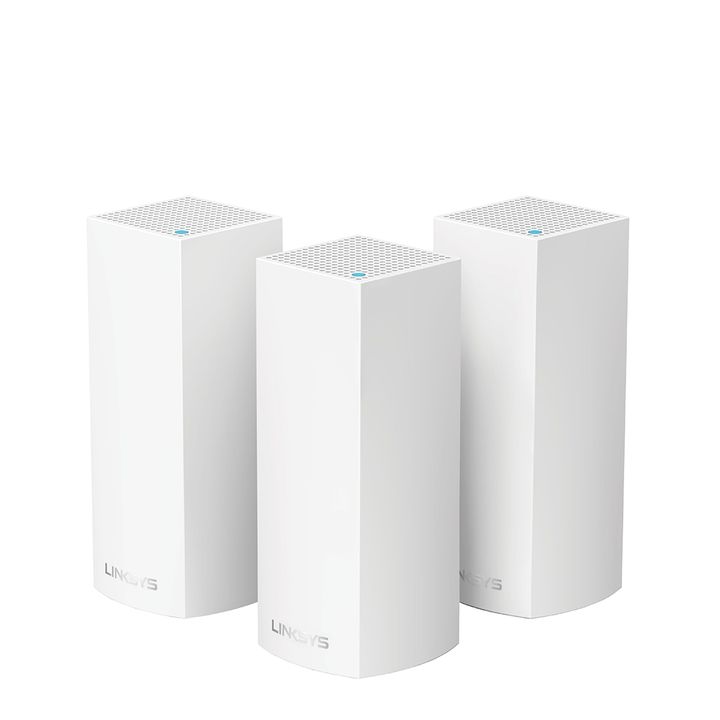
Let’s cut to the chase: the Linksys Velop Whole Home WiFi Mesh System ($450) was the answer to my wifi prayers and the solution to my wifi nightmares. It’s that simple.
Those nightmares — dead spots, low speeds, flaky connectivity and constant (often manual) switching between multiple hotspots — had persisted over multiple iterations of routers, extenders, repeaters, oversize antennas and more. But now they’re a thing of the past for me.
If you live in a dorm or one bedroom apartment, this system isn’t for you. You should be able to get good coverage from a single router. But if those nightmares sound familiar, read on.
At 2,100 square feet (3 BR, 2.5 BA), my home is nice but not enormous. But it’s a two level, stair-stepped hillside home, with a concrete retaining wall between the levels, a brick chimney between the living room and den, and an unusual zig-zag shaped upper level that forces signals to travel through exterior walls, or attempt to, as they pass from room to room.
To make matters worse, my wiring closet — where my router was located — is underneath the stairs between the two levels. That means it’s shielded by wood beams and that retaining wall. All of this made it impossible to cover the house with a single router, even a powerful one (eight antennas! it looks like a giant crab) augmented by an extender.
I had my doubts about whether the standard Velop three-pack — three units — would be up to the task either. I thought I might need five units, and that I’d probably have to drill holes and move the base unit — the one connected to the cable modem — out of that under-the-stairs wiring closet.
I was wrong. The three-pack did the job, even with the base unit locked away under the stairs.
But let’s rewind. What is a whole home wifi network, and more particularly a mesh system?
Simply put, a whole home wifi system is a two- or more-unit system that’s intended to blanket your home with a single wifi network. No more switching between MyNet 2.4, MyNet 5, MyNetExtender, MyDownstairsNet, etc. It’s all just MyNet, or whatever you want to call your network. And no more dead spots, assuming the system is powerful enough for your conditions — size, walls, levels, etc.
A mesh network is a particular type of whole home wifi system. Unlike some of the other technologies, mesh networks are often indefinitely expandable. For that reason, mesh networks are used commercially on college campuses and industrial complexes. The Velop is essentially a home version of that technology, and is expandable up to ten units.
Installation was easy. Unboxing revealed three identical small, attractive white towers, with power adapters and a card that instructed me to download the Linksys app to my phone (iOS or Android) and follow instructions. No manual is provided or even referenced, though it turns out that one is available online.
The app was straightforward. I unplugged my existing router, plugged in one of the Linksys units, and went through a number of easy steps until it was connected. I then went upstairs and placed a second unit in the front hallway and followed instructions again.
At this point, the app warned me that the second unit was a bit too far from the base unit, which could result in unnecessarily slow speeds. So I repositioned the unit and repeated, this time successfully. I then positioned a third unit, this time without complaint.
And I was done. Total elapsed time for the above: about twenty minutes. Testing revealed connectivity throughout the house at high speeds. I’ve been using the system for about three weeks now without problems. The app offers a variety of features, such as guest wifi and parental controls, a list of connected devices, and more granular, geeky controls that you probably won’t need.
Now, a few notes: some of my devices were able to connect immediately, because I used the same name and password for the Velop that I had used with my router wifi. But other devices weren’t able to connect until I relinked them to the network and manually reentered the password, a one-time but tedious operation when you have a variety of AV gear. This would likely be the case with any new network, though, and is not specific to the Linksys system.
The Velop supports WPS pushbutton wifi linking (through a soft button in the app rather than a physical button on the unit) which theoretically eliminates the need to retype passwords, but only one of my devices, a Samsung printer, successfully connected this way. That, however, was a win-win, since I’d been unable to get that printer to reliably connect at all to my previous, router-based network. A few weeks later, though, the Samsung is offline again. I’m chalking that up to the printer, not the Velop.
Also noteworthy, the Velop does not have a USB port. That means you can’t attach a hard disk for NAS (Network Attached Storage). That will be a disappointment for a small minority of users, not including me.
But another limitation did affect me: the Velop units each have only two Ethernet ports, as is typically the case with whole home systems. Your existing router probably has at least four ports for connecting devices, and a fifth for connection to the cable or DSL modem. On the Velop base unit, one of the ports is needed for connecting to the modem, leaving only one free for wired connections. I needed more wired connections, one for my PC and others for various other devices.
The solution, I suspected, would be to turn my router into a switch, essentially disabling most of the router except the ability to use the Ethernet ports. A Google search and consultation with Linksys tech support (24/7), confirmed that this would work, and provided some necessary details.
Thus, before I disconnected the router, I connected to its control interface via a browser, shut off its wifi, and set its Internet connectivity to “bridge” or “switch” mode. If you’re not tech savvy — or even if you are, probably — you’ll need to consult your router manual on how to do this or call your router manufacturer’s tech support. Or ask Google, which knows all and tells all. Try “use [router model] as a switch or bridge.”
Next, I installed the Velop system as described above. Then I accessed the router again via my wired PC (which at this point had no Internet connectivity but was still connected to the router). I set the router to use a static IP address I randomly chose within the range that the Velop was using, which I determined by consulting the app on my phone. Then I had to set several other parameters as well. For subnet, I used the same subnet as the Velop used (determined by consulting the app again); for gateway, I copied the Velop’s IP address (likewise); and for DNS, at tech support’s instruction, I specified 8.8.8.8.
And, finally, I plugged the router (via its WAN/Internet Ethernet port) into the Velop base unit. Voila, my wired devices were back online.
This process sounds complex, but it’s only necessary if you need to plug more than one wired device into the Velop base unit (or more than two wired devices into any of the Velop satellite units). And if you want to avoid the hassle, just buy an inexpensive Ethernet switch, such as the Linksys SE2500 ($43, not tested) or the even more economical TP-Link TL-SG1005D ($15, not tested), and use it instead of your router.
Speaking of cost, the Linksys Velop is a bit more expensive than its competitors, some which aren’t true mesh networks and at least one of which comes with only two units. I haven’t tested the others, so all I can say is, do your homework. Well, I can also say this: the Linksys Velop solved my tough wifi problems. It might well solve yours too.
Linksys provided review product.
